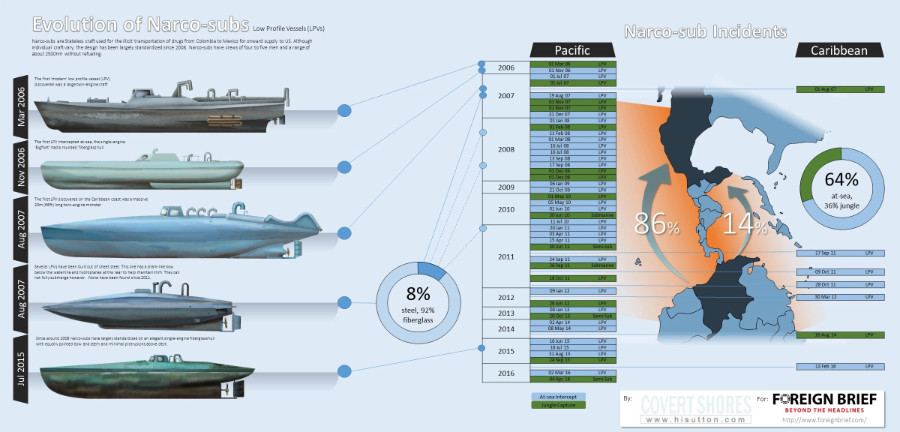2016 looks set to be a bumper year for narco-sub incidents.
Just last month, Colombian security forces discovered a 15-metre narco-sub in the jungle near the Pacific coast. A few weeks earlier, the U.S. Coast Guard published footage of a narco-sub intercepted off the Panamanian coast with 5.5 tonnes of cocaine on board, valued at $200 million. In March, an abandoned narco-sub was found stranded on a reef off the Yucatan peninsula in Mexico, its load of narcotics already unloaded by drug smugglers.
Narco-subs are purpose-built, semi-submersible drug smuggling vessels that operate illegally as ‘stateless vessels’. Most narco-subs are owned by Colombian drug cartels and operate as part of a transnational criminal network transporting cocaine from South to North America.
Original artwork - CLICK for HIGH-RESOLUTION (2400px) image.

Before narco-subs, cartels primarily used light aircraft to smuggle their goods. However, this became increasingly risky as regional law enforcement agencies began to coordinate their efforts. Initially, this led to drug runners using ‘go-fast’ boats – powerboats with extra outboard engines – however, despite reaching impressive speeds, these were never fast enough to outrun coast guard helicopters. The answer lay in a slower, stealthier design carrying a much larger payload: the narco-sub.
The attraction of such vessels is straightforward economics. A typical narco-sub carries about six tonnes of cocaine, valued at roughly $180 million and equivalent to about 2,500 human drug mules. Therefore, the unit cost of a narco-sub and its crew are minimal....
Read full article on -> 
Related articles
 Narco Subs 101
Narco Subs 101
 LTTE Sea Tigers' sneak craft and midget subs
LTTE Sea Tigers' sneak craft and midget subs


 Taedong-B 'Kajami' ('Zulfikar') submersible boat
Taedong-B 'Kajami' ('Zulfikar') submersible boat
